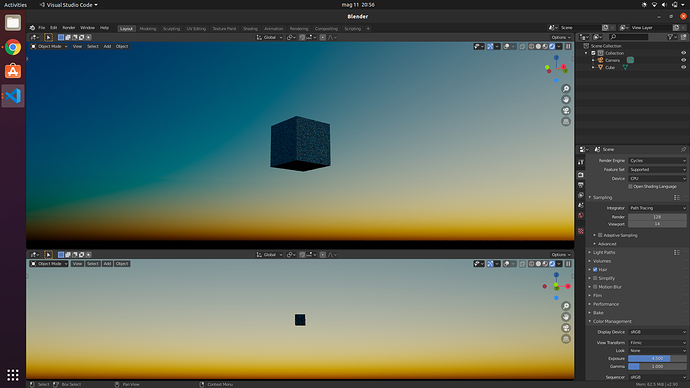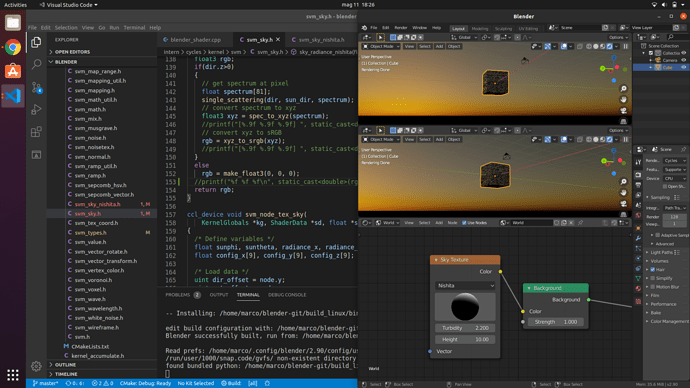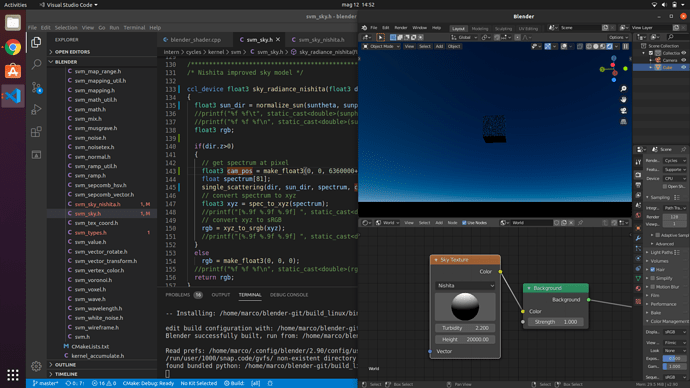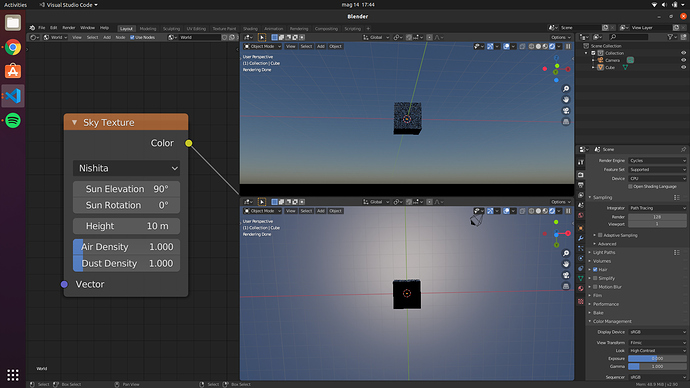Incase anyone wants to play, win64 test build available here
https://blender.community/c/graphicall/2mbbbc/
Had to fix some minor bugs, and while i managed to get the GPU kernels to build, they didn’t work, so they are not included.
@nacioss small diff with changes:
diff --git a/intern/cycles/kernel/svm/svm_sky_nishita.h b/intern/cycles/kernel/svm/svm_sky_nishita.h
index fb5196c23d7..439f2a2b996 100644
--- a/intern/cycles/kernel/svm/svm_sky_nishita.h
+++ b/intern/cycles/kernel/svm/svm_sky_nishita.h
@@ -11,18 +11,18 @@ ccl_constant float No = 2.504f*powf(10,25); // number density of air
ccl_constant float D = 149.6f*powf(10,9); // average distance Earth-Sun (m)
ccl_constant int Rs = 695500000; // radius of Sun (m)
*/
-ccl_constant int Hr = 8000; // Rayleigh scale height (m)
-ccl_constant int Hm = 1200; // Mie scale height (m)
-ccl_constant float mie_coeff = 21.0f*powf(10,-6)*1.11f; // Mie scattering coefficient
-ccl_constant float G = 0.76f; // aerosols anisotropy
-ccl_constant int Re = 6360000; // radius of Earth (m)
-ccl_constant int Ra = 6420000; // radius of atmosphere (m)
+ccl_static_constant int Hr = 8000; // Rayleigh scale height (m)
+ccl_static_constant int Hm = 1200; // Mie scale height (m)
+ccl_static_constant float mie_coeff = 21.0f * 1e-06 * 1.11f; // Mie scattering coefficient
+ccl_static_constant float G = 0.76f; // aerosols anisotropy
+ccl_static_constant int Re = 6360000; // radius of Earth (m)
+ccl_static_constant int Ra = 6420000; // radius of atmosphere (m)
// sRGB illuminant
-ccl_constant float D65[3][3] = {{3.2404542f, -1.5371385f, -0.4985314f},
+ccl_static_constant float D65[3][3] = {{3.2404542f, -1.5371385f, -0.4985314f},
{-0.9692660f, 1.8760108f, 0.0415560f},
{0.0556434f, -0.2040259f, 1.0572252f}};
// wavelengths from 380 to 780nm in 5nm steps
-ccl_constant float lam[81] = {0.000000380f,
+ccl_static_constant float lam[81] = {0.000000380f,
0.000000385f,
0.000000390f,
0.000000395f,
@@ -104,7 +104,8 @@ ccl_constant float lam[81] = {0.000000380f,
0.000000775f,
0.000000780f};
// irradiance on top of atmosphere
-ccl_constant float irradiance[81] = {1.45756829855592995315f,
+ccl_static_constant float irradiance[81] = {
+ 1.45756829855592995315f,
1.48681810145193371575f,
1.51463734934585536607f,
1.54101945617374802566f,
@@ -186,7 +187,8 @@ ccl_constant float irradiance[81] = {1.45756829855592995315f,
1.21264859984538175830f,
1.19975998755420620867f};
// Rayleigh scattering coefficient
-ccl_constant float rayleigh_coeff[81] = {0.00005424820087636473f,
+ccl_static_constant float rayleigh_coeff[81] = {
+ 0.00005424820087636473f,
0.00005148453658164692f,
0.00004889464506876970f,
0.00004646557796171550f,
@@ -268,7 +270,8 @@ ccl_constant float rayleigh_coeff[81] = {0.00005424820087636473f,
0.00000313554411920575f,
0.00000305591531679811f};
// Ozone absorption coefficient
-ccl_constant float ozone_coeff[81] = {0.01514919300429610517f,
+ccl_static_constant float ozone_coeff[81] = {
+ 0.01514919300429610517f,
0.01410074537010751541f,
0.01595346734928488469f,
0.02486574480525617983f,
@@ -350,7 +353,7 @@ ccl_constant float ozone_coeff[81] = {0.01514919300429610517f,
0.70781292228739933758f,
0.78412491447593057892f};
// CIE XYZ color matching functions
-ccl_constant float cmf_xyz[81][3] = {{0.0014f, 0.0000f, 0.0065f},
+ccl_static_constant float cmf_xyz[81][3] = {{0.0014f, 0.0000f, 0.0065f},
{0.0022f, 0.0001f, 0.0105f},
{0.0042f, 0.0001f, 0.0201f},
{0.0076f, 0.0002f, 0.0362f},
@@ -469,7 +472,7 @@ ccl_device float phase_mie(float mu)
ccl_device float distance_points(float3 P1, float3 P2)
{
- return sqrtf(powf((P2[0]-P1[0]),2)+powf((P2[1]-P1[1]),2)+powf((P2[2]-P1[2]),2));
+ return sqrtf(powf((P2.x-P1.x),2)+powf((P2.y-P1.y),2)+powf((P2.z-P1.z),2));
}
ccl_device float3 normalize(float lat, float lon)
@@ -484,24 +487,24 @@ ccl_device float3 normalize_sun(float lat, float lon)
ccl_device float angle_vectors(float3 rot1, float3 rot2)
{
- return rot1[0]*rot2[0]+rot1[1]*rot2[1]+rot1[2]*rot2[2];
+ return rot1.x*rot2.x+rot1.y*rot2.y+rot1.z*rot2.z;
}
ccl_device float3 atmosphere_intersection(float3 pos, float3 dir)
{
- float a = powf(dir[0],2)+powf(dir[1],2)+powf(dir[2],2);
- float b = -2.0f*(dir[0]*(-pos[0])+dir[1]*(-pos[1])+dir[2]*(-pos[2]));
- float c = powf(-pos[0],2)+powf(-pos[1],2)+powf(-pos[2],2)-powf(Ra,2);
+ float a = powf(dir.x,2)+powf(dir.y,2)+powf(dir.z,2);
+ float b = -2.0f*(dir.x*(-pos.x)+dir.y*(-pos.y)+dir.z*(-pos.z));
+ float c = powf(-pos.x,2)+powf(-pos.y,2)+powf(-pos.z,2)-powf(Ra,2);
float t = (-b+sqrtf(powf(b,2)-4.0f*a*c))/(2.0f*a);
- return make_float3(pos[0]+dir[0]*t, pos[1]+dir[1]*t, pos[2]+dir[2]*t);
+ return make_float3(pos.x+dir.x*t, pos.y+dir.y*t, pos.z+dir.z*t);
}
ccl_device bool surface_intersection(float3 pos, float3 dir)
{
- if (dir[2]>=0)
+ if (dir.z>=0)
return false;
- float t = (-pos[0]*dir[0]-pos[1]*dir[1]-pos[2]*dir[2])/(powf(dir[0],2)+powf(dir[1],2)+powf(dir[2],2));
- float D = powf(-pos[0],2)-2.0f*-pos[0]*dir[0]*t+powf(dir[0]*t,2)+powf(-pos[1],2)-2.0f*(-pos[1])*dir[1]*t+powf(dir[1]*t,2)+powf(-pos[2],2)-2.0f*(-pos[2])*dir[2]*t+powf(dir[2]*t,2);
+ float t = (-pos.z*dir.z-pos.y*dir.y-pos.z*dir.z)/(powf(dir.z,2)+powf(dir.y,2)+powf(dir.z,2));
+ float D = powf(-pos.z,2)-2.0f*-pos.z*dir.z*t+powf(dir.z*t,2)+powf(-pos.y,2)-2.0f*(-pos.y)*dir.y*t+powf(dir.y*t,2)+powf(-pos.z,2)-2.0f*(-pos.z)*dir.z*t+powf(dir.z*t,2);
if (D<=powf(Re,2))
return true;
else
@@ -511,6 +514,7 @@ ccl_device bool surface_intersection(float3 pos, float3 dir)
ccl_device float3 spec_to_xyz(float *spectrum)
{
float x, y, z;
+ x = y = z = 0.0f;
for(int i=0; i<80; i++)
{
x += cmf_xyz[i][0]*spectrum[i];
@@ -525,15 +529,14 @@ ccl_device float3 spec_to_xyz(float *spectrum)
ccl_device float3 xyz_to_srgb(float3 xyz)
{
- float R = D65[0][0]*xyz[0] + D65[0][1]*xyz[1] + D65[0][2]*xyz[2];
- float G = D65[1][0]*xyz[0] + D65[1][1]*xyz[1] + D65[1][2]*xyz[2];
- float B = D65[2][0]*xyz[0] + D65[2][1]*xyz[1] + D65[2][2]*xyz[2];
+ float R = D65[0][0]*xyz.x + D65[0][1]*xyz.y + D65[0][2]*xyz.z;
+ float G = D65[1][0]*xyz.x + D65[1][1]*xyz.y + D65[1][2]*xyz.z;
+ float B = D65[2][0]*xyz.x + D65[2][1]*xyz.y + D65[2][2]*xyz.z;
float exposure = 100000.0f;
return make_float3(R*exposure, G*exposure, B*exposure);
}
-ccl_constant float3 earth_center = make_float3(0, 0, 0);
ccl_constant int samples = 32;
ccl_constant int samples_light = 16;
@@ -558,6 +561,7 @@ ccl_device void single_scattering(float3 cam_dir, float3 sun_dir, float *spectru
float optical_depthO = 0;
float phaseR = phase_rayleigh(mu);
float phaseM = phase_mie(mu);
+ float3 earth_center = make_float3(0, 0, 0);
// for each point along AB
for(int i=0; i<samples; i++)
{
@@ -634,4 +638,4 @@ ccl_device void single_scattering(float3 cam_dir, float3 sun_dir, float *spectru
}
-CCL_NAMESPACE_END
\ No newline at end of file
+CCL_NAMESPACE_END











